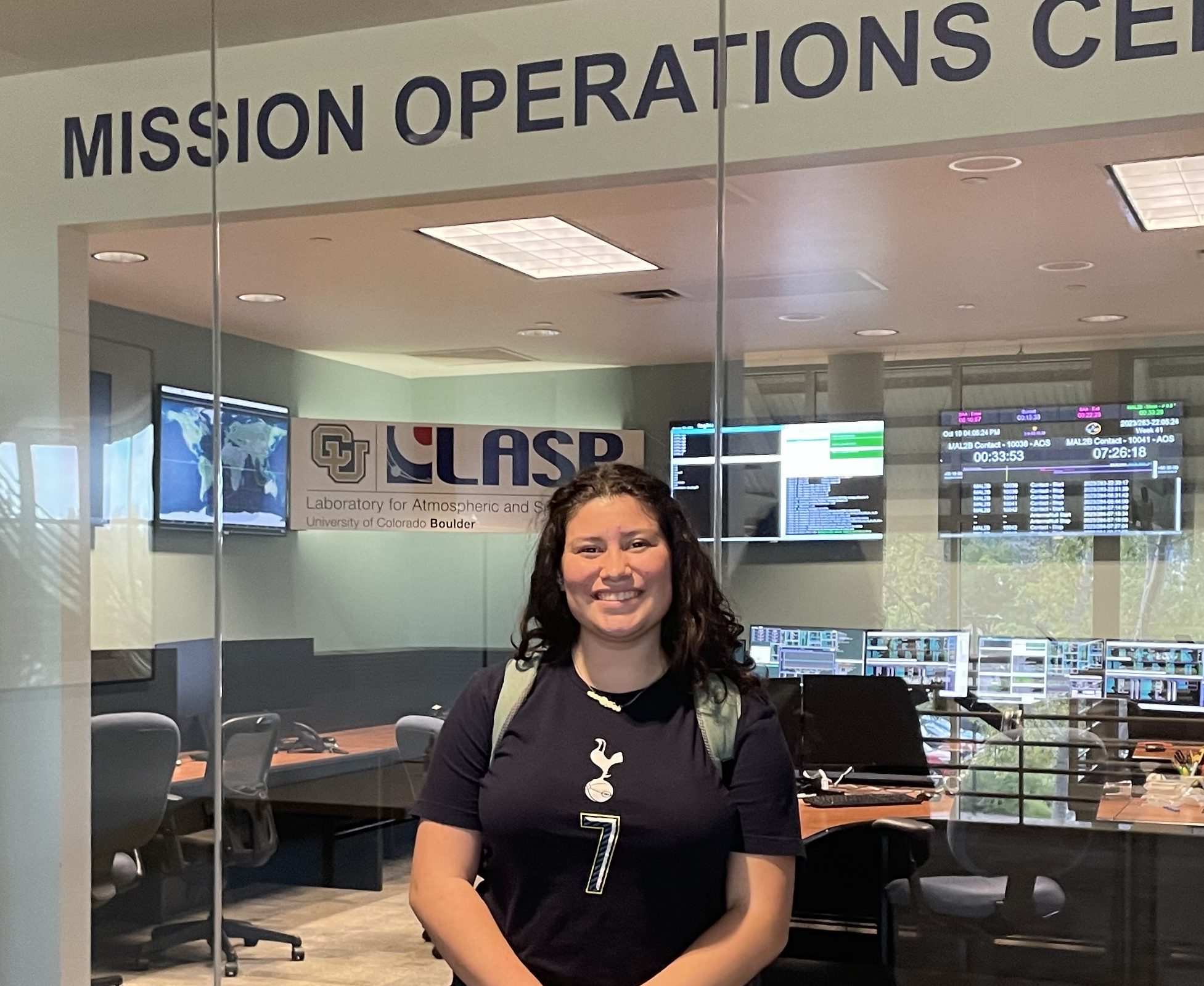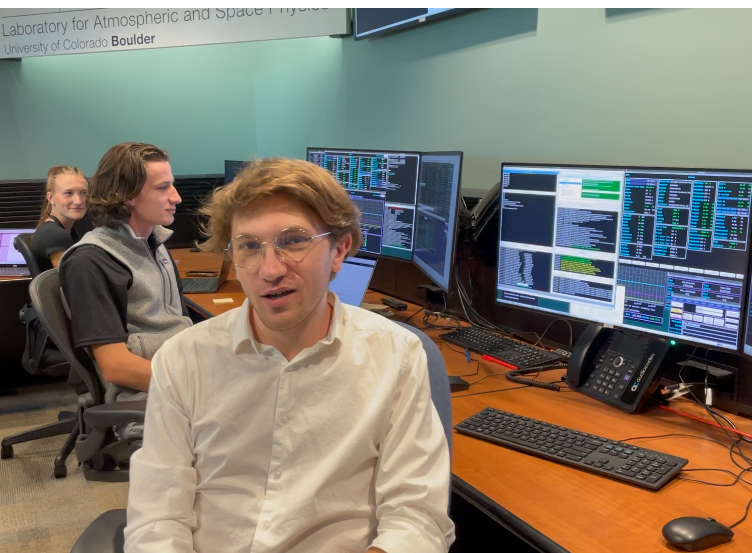The large wall monitor displaying a countdown shows 17 seconds when Amelia "Mia" De Herrera-Schnering tells her teammates “We have AOS,” meaning “acquisition of signal.”
“Copy that, thank you,” Alexander Pichler replies. The two are now in contact with NASA’s IXPE (Imaging X-Ray Polarimeter Explorer) spacecraft, transmitting science data from IXPE to a ground station and making sure the download goes smoothly. That data will then go to the science team for further analysis.
At LASP, the Laboratory for Atmospheric and Space Physics, students at the University of Colorado, Boulder, can train to become command controllers, working directly with spacecraft on pointing the satellites, calibrating instruments, and collecting data. De Herrera-Schnering recently completed her sophomore year, while Pichler had trained as a student and now, having graduated, works as a full-time professional at LASP.
“The students are a key part in what we do,” said Stephanie Ruswick, IXPE flight director at LASP. “We professionals monitor the health and safety of the spacecraft, but so do the students, and they do a lot of analysis for us.”
Students also put into motion IXPE’s instrument activity plans, which are provided by the Science Operations Center at NASA’s Marshall Space Flight Center in Huntsville, Alabama. The LASP student team schedules contacts with ground stations to downlink data, schedules observations of scientific and calibration targets, and generates the files necessary to translate the scientific operations into spacecraft actions. If IXPE experiences an anomaly, the LASP team will implement plans to remediate and resume normal operations as soon as possible.
Exploring the high-energy universe
The students take part in IXPE's exploration of a wide variety of celestial targets. In October, for example, students monitored the transmission of data from IXPE’s observations of Swift J1727.8-1613, a bright black hole X-ray binary system. This cosmic object had been recently discovered in September 2023, when NASA's Neil Gehrels Swift Observatory detected a gamma-ray burst. IXPE’s specialized instruments allow scientists to measure the polarization of X-rays, which contains information about the source of the X-rays as well as the organization of surrounding magnetic fields. IXPE’s follow-up of the Swift object exemplifies how multiple space missions often combine their individual strengths to paint a fuller scientific picture of distant phenomena.
Team members also conduct individual projects. For example, students analyzed how IXPE would fare during both the annular eclipse on Oct. 14, 2023, and the total eclipse that moved across North America on April 8, to make sure that the spacecraft would have adequate power while the Moon partially blocked the Sun.
While most of the students working on IXPE at LASP are engineering majors, some are physics or astrophysics majors. Some didn’t initially start their careers in STEM such as flight controller Kacie Davis, who previously studied art.
Prospective command controllers go through a rigorous 12-week summer training program working 40 hours per week, learning “everything there is to know about mission operations and how to fly a spacecraft,” Ruswick said.
Cole Writer, an aerospace engineering student, remembers this training as “nerve-wracking” because he felt intimidated by the flight controllers. But after practicing procedures on his own laptop, he felt more confident, and completed the program to become a command controller.
“It’s nice to be trained by other students who are in the same boat as you and have gone through the same process,” said Adrienne Pickerill, a flight controller who started with the team as a student and earned a Master's in aerospace engineering at the university in May .
How they got here
As a teenager Writer’s interests focused on flying planes, and he saved money to train for a pilot’s license, earning it the summer after high school graduation. Surprisingly, he has found many overlaps in skills for both activities – following checklists and preventing mistakes. “Definitely high stakes in both cases,” he said.
Sam Lippincott, now a graduate student lead after serving as a command controller as an undergraduate, has been a lifelong sci-fi fan, but took a career in space more seriously his sophomore year of college. “For people that want to go into the aerospace or space operations industry, it’s always important to remember that you’ll never stop learning, and it’s important to remain humble in your abilities, and always be excited to learn more,” he said.
De Herrera-Schnering got hooked on the idea of becoming a scientist the first time she saw the Milky Way. On a camping trip when she was 10 years old, she spotted the galaxy as she went to use the outhouse in the middle of the night. “I woke up my parents, and we just laid outside and we were just stargazing,” she said. “After that I knew I was set on what I wanted to do.”
Rithik Gangopadhyay, who trained as an undergraduate command controller and continued at LASP as a graduate student lead, had been interested in puzzles and problem-solving as a kid and had a book about planets that fascinated him.. “There’s so much out there and so much we don’t know, and I think that’s what really pushed me to do aerospace and do this opportunity of being a command controller,” he said.
Coding is key to mission operations, and much of it is done in the Python language. Sometimes the work of flying a spacecraft feels like any other kind of programming — but occasionally, team members step back and consider that they are part of the grand mission of exploring the universe.
“If it's your job for a couple of years, it starts to be like, ‘oh, let's go ahead and do that, it's just another Tuesday.’ But if you step back and think about it on a high-level basis, it's really something special,” Pichler said. “It’s definitely profound.”
Media Contact
Elizabeth Landau
Headquarters, Washington
202-358-0845
elandau@nasa.gov





























